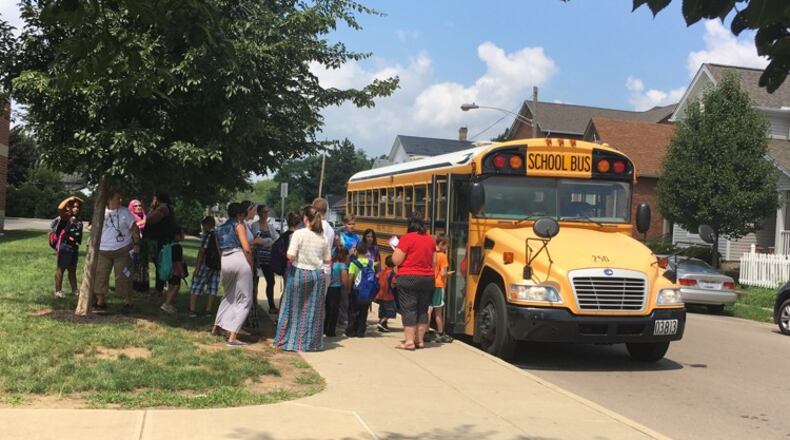In turn, the district would transport all students who attend Dayton schools on the district’s yellow buses.
SEPTEMBER 2019: Dayton schools fight busing confusion
Superintendent Elizabeth Lolli said the switch is being made for both financial and efficiency reasons.
“We have so many charter routes that we can’t do field trips for DPS students. We can’t get our buses to buildings on time,” Lolli said. “We’re trying to refine how we do it and get our schools down to three tiers of busing as opposed to four, so we get our students to school on time.”
Last school year, under a new contract, RTA ran buses on special “limited-service” routes designed to get students to and from DPS’ six high schools. Lolli said it’s not clear yet whether the charter and parochial students would have specially designed routes for their schools, or whether those students would ride existing RTA routes with the general public.
Lolli said DPS officials plan to have a conversation with RTA this week.
Dave Taylor, assistant superintendent of the DECA charter schools, which serve kindergarten through high school, cited several worries with the change.
AUGUST 2019: DPS starts Phase 1 of high school busing plan
“They’ve not communicated any details about this plan to charter schools,” Taylor said. “I have grave concerns about handing a kindergartner a bus pass and asking them to board an RTA bus.”
In addition to worries about young children’s safety, or their ability to manage transferring from one bus to another, Taylor said RTA has rules about who can ride.
RTA Executive Director Mark Donaghy confirmed RTA’s policy says all children age 12 and under must be accompanied by a parent, guardian or teacher when using RTA services.
Donaghy said Friday that RTA has not had any discussion with DPS about the details of any change for this fall.
He said if the school district intended to create limited service routes for charter and private schools, they could put a DPS employee acting as a bus aide on each of those buses to meet the rule about children 12 and under.
NOVEMBER 2019: Dayton schools’ attendance push off to slow start
Almost 10,000 Dayton students attend dozens of different charter and parochial schools spread around the community. Public school districts are legally required to offer some form of busing service for those charter and private school students who meet legal requirements.
DPS Business Manager Gary Dickstein said last year, DPS transported 2,090 charter school students in grades K-8, and the district paid for RTA passes for many charter high school students as well.
“We cannot be 100% sure on how much savings we will obtain — we know there will be savings though — until we know enrollment numbers and confirm the number of RTA passes we will be purchasing,” Dickstein said, adding those figures won’t be available until school is starting.
Karyn Hecker, regional director of the Archdiocese of Cincinnati’s Catholic Schools Office, said DPS would have to inform each affected Catholic school family in the district of their decision on busing. And if the family disagrees with the decision, they can request mediation.
Under Ohio law, public school districts also can declare that transporting certain students is not practical, and offer a $250 payment in lieu of transportation.
RELATED: How are schools planning to reopen buildings this fall?
Taylor said about 60% of DECA’s kindergarten through eighth-grade students ride DPS buses. He said making a switch this late puts charter schools in a bad spot, because even if they wanted to arrange their own transportation system, the state deadline to do so for this fall has already passed.
“I understand fiscally the decision that they’re making, but I would have to ask the question, is it what’s best for the district or is it what’s best for the city of Dayton?” Taylor said. “Are we considering that all kids in our schools matter, or are just saying that some kids matter?”
Donaghy said RTA would have to see the locations of all the affected charter and private schools to determine how limited service busing for those schools would work.
He said RTA’s contract with DPS is a five-year agreement with four years still to go, at about $3 million per year. Either side can give 120 days notice to terminate it.
Other busing issues
DPS also considered, but then put off a change that would have eliminated most busing for students who live in one quadrant of the school district, but attend a school in another quadrant.
District officials said the change would help with efficiency of getting students to school on time, as well as cost of busing. But multiple school board members expressed concerns, with Will Smith first raising concerns of increased racial segregation, and Dion Sampson asking whether the move would affect educational equity across the district.
SCHOOLS: Legislature approves law on graduation, funding, religion
At its upcoming meeting on Saturday, the school board still is scheduled to discuss eliminating cross-quadrant busing for purposes of daycare. Lolli said that has at times resulted in a school bus taking just one or two students across town, hindering busing efficiency.
About the Author

